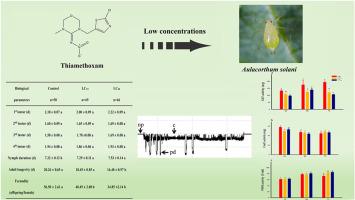Toxicity and sublethal effects of thiamethoxam on life-history traits, feeding behavior, and detoxifying metabolism of Aulacorthum solani
IF 2.5
2区 农林科学
Q1 AGRONOMY
引用次数: 0
Abstract
The foxglove aphid, Aulacorthum solani (Hemiptera: Aphididae), has emerged as a significant pest in soybean fields. Currently, no insecticides were registered for its management on soybean. Thiamethoxam, widely used to control Aphis glycines, represents a potential candidate for managing A. solani. However, the toxicity and sublethal effects of thiamethoxam on A. solani remain poorly understood and warrant further investigation. In addition to inducing direct mortality through typical acute toxicity (lethal effects), insecticides can significantly disrupt various key biological traits and population growth of aphids through physiologically and behaviorally mediated sublethal impacts, which must be thoroughly considered to comprehensively evaluate its overall impacts. Here, we assessed its life-history traits through an age-stage, two-sex life table, evaluated activities of detoxification enzymes, and examined the feeding behavior of A. solani using electropenetrography (EPG). Bioassays revealed thiamethoxam exhibited acute toxicity to A. solani (LC50: 2.138 mg/L at 24 h). Exposure to low-lethal concentrations (LC15 and LC30) of thiamethoxam significantly reduced the adult longevity and fecundity of F0 A. solani. Moreover, it also significantly reduced the life-history traits of F1 A. solani. EPG recordings demonstrated that thiamethoxam significantly prolonged the time to first probe and total duration of nonprobing time (np), and decreased total duration of E1. Enzymatic assays indicated that thiamethoxam exposure decreased activity of glutathione S-transferase (GST), while enhanced activity of cytochrome P450 monooxygenases (P450) in adult aphids. These findings showed that thiamethoxam has a great efficient against A. solani, and sublethal concentrations of thiamethoxam exhibit significant negative effects on A. solani. Our results highlight its potential for IPM strategies targeting this emerging soybean pest.

噻虫嗪对茄白弧菌生活史特征、摄食行为和解毒代谢的毒性和亚致死效应
毛地黄蚜(Aulacorthum solani,半翅目:蚜虫科)已成为大豆田的重要害虫。目前未对大豆进行农药管理登记。噻虫嗪被广泛用于控制蚜虫甘氨酸,是控制茄蚜的潜在候选药物。然而,噻虫嗪对茄蚜的毒性和亚致死作用仍然知之甚少,需要进一步研究。杀虫剂除了通过典型的急性毒性(致死效应)导致直接死亡外,还可以通过生理和行为介导的亚致死效应显著破坏蚜虫的各种关键生物学性状和种群生长,必须充分考虑这些影响才能全面评估其总体影响。本研究通过年龄阶段、两性生命表对茄茄的生活史特征进行了评估,对解毒酶活性进行了评估,并利用电渗透(EPG)技术对茄茄的摄食行为进行了研究。生物测定结果显示噻虫嗪对茄蚜具有急性毒性(24 h LC50: 2.138 mg/L)。低致死浓度(LC15和LC30)噻虫嗪暴露显著降低了茄蚜成虫寿命和繁殖力。此外,它还显著降低了茄茄的生活史性状。EPG记录显示噻虫嗪显著延长了第一次探测时间和总非探测时间(np),降低了总E1持续时间。酶促试验表明,噻虫嗪降低了成虫体内谷胱甘肽s -转移酶(GST)的活性,增强了细胞色素P450单加氧酶(P450)的活性。结果表明,噻虫嗪对茄蚜有较好的杀灭效果,亚致死浓度噻虫嗪对茄蚜有显著的负作用。我们的研究结果强调了针对这种新兴大豆害虫的IPM策略的潜力。
本文章由计算机程序翻译,如有差异,请以英文原文为准。
求助全文
约1分钟内获得全文
求助全文
来源期刊

Crop Protection
农林科学-农艺学
CiteScore
6.10
自引率
3.60%
发文量
200
审稿时长
29 days
期刊介绍:
The Editors of Crop Protection especially welcome papers describing an interdisciplinary approach showing how different control strategies can be integrated into practical pest management programs, covering high and low input agricultural systems worldwide. Crop Protection particularly emphasizes the practical aspects of control in the field and for protected crops, and includes work which may lead in the near future to more effective control. The journal does not duplicate the many existing excellent biological science journals, which deal mainly with the more fundamental aspects of plant pathology, applied zoology and weed science. Crop Protection covers all practical aspects of pest, disease and weed control, including the following topics:
-Abiotic damage-
Agronomic control methods-
Assessment of pest and disease damage-
Molecular methods for the detection and assessment of pests and diseases-
Biological control-
Biorational pesticides-
Control of animal pests of world crops-
Control of diseases of crop plants caused by microorganisms-
Control of weeds and integrated management-
Economic considerations-
Effects of plant growth regulators-
Environmental benefits of reduced pesticide use-
Environmental effects of pesticides-
Epidemiology of pests and diseases in relation to control-
GM Crops, and genetic engineering applications-
Importance and control of postharvest crop losses-
Integrated control-
Interrelationships and compatibility among different control strategies-
Invasive species as they relate to implications for crop protection-
Pesticide application methods-
Pest management-
Phytobiomes for pest and disease control-
Resistance management-
Sampling and monitoring schemes for diseases, nematodes, pests and weeds.
 求助内容:
求助内容: 应助结果提醒方式:
应助结果提醒方式:


